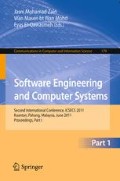Abstract
Collaborative learning environment is regarded as stimulating and engaging for normal learners. The main aim of our research is to investigate its effectiveness in assisting the learning of children with disabilities. We developed a prototype, Learn with Me and conducted a testing on 6 children who have been diagnosed with cerebral palsy and 7 children who have been diagnosed with autism spectrum disorders. Participants were invited to take part in two tests. Result showed participants learn better with responsive virtual tutor as compared to non-responsive virtual learning.
Access this chapter
Tax calculation will be finalised at checkout
Purchases are for personal use only
Preview
Unable to display preview. Download preview PDF.
References
Majumdar, R., Laisram, N., Chowdhary, S.: Associated handicaps in cerebral palsy. IJPMR 17(1), 11–13 (2006)
Bax, M., Cockerill, H., Carroll-Few, L.: Who needs augmentative communication, and when? In: Cockerill, H., Carroll-Few, L. (eds.) Communication Without Speech: Practical Augmentative & Alternative Communication, pp. 65–71. Mac Keith Press, London (2001)
Remus, M.: Autism and school based programming (Strategies for meeting the needs of low functioning autistic children), http://www.telusplanet.net/public/nremus/communication.htm , (viewed November 12, 2010)
Schneider, E.D.: Communication disorders in children with autism: characteristics, assessment, treatment. In: Gupta, V.B. (ed.) Autistic Spectrum Disorders in Children, pp. 161–174. Marcell Dekker, New York (2004)
Adams, J.B., Edelson, S.M., Grandin, T., Rimland, B.: Advice for parents of young autistic children (2004): working paper, http://www.autismtoday.com/adviceforparents.pdf , (viewed December 2, 2010)
Valente, J.A.: Creating a computer-based learning environment for physically handicapped children, Ph.D. dissertation, Massachusetts Institute of Technology, Cambridge, USA (1983)
Russell, J., Jarrold, C., Henry, L.: Working Memory in Children with Autism and with Moderate Learning Difficulties. Journal of Child Psychology and Psychiatry 37(6), 673–686 (1996)
Degreefinders,: How to become a special education teacher, http://www.degreefinders.com/education-articles/careers/how-to-become-a-special-education-teacher.html , (viewed January 28, 2011)
BecomeaTeacher,: Special education, http://www.becomeateacher.info/Special-Education.asp , (viewed January 15, 2011)
Meyers, J.:Characteristics of a special education teacher (2001), http://connected.waldenu.edu/special-education/special-education-teachers/item/1671-characteristics-of-special-education-teacher , (viewed January 2, 2011)
Aleven, V., Koedinger, K.R.: Limitation of student control: do students know when they need help? In: Gauthier, G., Frasson, C., VanLehn, K. (eds.) Proc. 5th Int. Conf. Intelligent Tutoring Systems, pp. 292–303. Springer, Berlin (2000)
Fuller, A.: Ten reasons to homeschool your child with special needs (2009), http://creation.com/images/pdfs/home-school-corner/special-needs/6663ten-reasons-to-hs-your-child-with-special-needs.pdf , (viewed December 24, 2010)
Kilanowski-Press, L., Foote, C.J., Rinaldo, V.J.: Inclusion classrooms and teachers: a survey of current practices. Int. J. Special Education 25(3), 44–56 (2010)
Whalen, C., Liden, L., Ingersoll, B., Dallaire, E., Liden, S.: Behavioral improvements associated with computer-assisted instruction for children with developmental disabilities. J. Speech-Language Pathology and Applied Behavior Analysis 1(1) (2006)
Alexander, S., Sarrafzadeh, A., Hill, S.: Easy with Eve: a functional affective tutoring system. In: Workshop Motivational and Affective Issues in ITS. 8th Int. Conf. ITS 2006, pp. 38–45 (2006)
Sarrafzadeh, A., Hosseini, H.G., Fan, C., Overmyer, S.P.: Facial expression analysis for estimating learner’s emotional state in intelligent tutoring systems. In: Proc. 3rd IEEE Int. Conf. on Advanced Learning Technologies (ICALT 2003), p. 336 (2003)
Whitehill, J., Bartlett, M., Movellan, J.: Automatic facial recognition for intelligent tutoring systems. In: Proc. CVPR 2008 Workshop Human Communicative Behavior Analysis (2008)
Sarrafzadeh, A., Alexander, S., Dadgostar, F., Fan, C., Bigdeli, A.: See me, teach me: facial expression and gesture recognition for intelligent tutoring systems. In: Proc. IEEE Int. Conf. Innovations in Information Technology (IIT 2006), pp. 1–5 (2006)
Ong, C.A., Lu, M.V., Lau, B.T.: A Face Based Real Time Communication for Physically and Speech Disabled People. In: Lau, B.T. (ed.) Assistive and Augmentive Communication for the Disabled: Intelligent Technologies for Communication, Learning and Teaching, IGI Global Publishing (submitted for publication)
Springer, K.: Educational Research: A Contextual Approach. Wiley, USA (2010)
Breach, M.: Dissertation Writing for Engineers and Scientists. Pearson Prentice Hall, UK (2009)
Mack, N., Woodsong, C., MacQuen, K.M., Guest, G., Namey, E.: Module 2 – Participation Observation. In: Qualitative Research Methods: A Data Collector’s Field Guide, Family Health International, USA (2005)
Laurier, E.: Participant observation. In: Clifford, N., Valentine, G. (eds.) Research Methods in Human and Physical Geography, Sage, London (2003)
Jorgensen, D.L.: Participant Observation : A Methodology for Human Studies. Sage Publications, London (1989)
Vockell, E.L.: Educational psychology: a practical approach(1995-2001), http://education.calumet.purdue.edu/vockell/edPsybook/Edpsy7/edpsy7_meta.htm , ( viewed December 23, 2010)
Dawson, P., Guare, R.: Executive Skills in Children and Adolescents: A Practical Guide to Assessment and Intervention, 2nd edn. The Guilford Press, New York (2010)
Perner, J., Frith, U., Leslie, A.M., Leekam, S.R.: Exploration of the autistic child’s theory of mind: knowledge, belief, and communication. Child Development 60, 689–700 (1989)
Ryan, C., Charragáin, C.N.: Teaching emotion recognition skills to children with autism. J. Autism and Developmental Disorders 40(12), 1505–1511 (2010)
Fabri, M., Moore, D.J.: The use of emotionally expressive avatars in collaborative virtual environments. In: Proc. Symposium Emphatic Interaction with Synthetic Characters, at Artificial Intelligence and Social Behavior Convention 2005 (AISB 2005). University of Hertfordshire, UK (2005)
Hill, M.L., Craig, K.D.: Detecting deception in pain expressions: the structure of genuine and deceptive facial displays. Pain 98, 135–144 (2002)
Falkman, K.W., Sandberg, A.D., Hjelmquist, E.: Theory of mind in children with cerebral palsy and severe speech impairment. Göteberg Psychological Reports 34(2), 1–16 (2004)
Author information
Authors and Affiliations
Editor information
Editors and Affiliations
Rights and permissions
Copyright information
© 2011 Springer-Verlag Berlin Heidelberg
About this paper
Cite this paper
Valeria, N., Lau, B.T. (2011). Learn with Me: Collaborative Virtual Learning for the Special Children. In: Mohamad Zain, J., Wan Mohd, W.M.b., El-Qawasmeh, E. (eds) Software Engineering and Computer Systems. ICSECS 2011. Communications in Computer and Information Science, vol 179. Springer, Berlin, Heidelberg. https://doi.org/10.1007/978-3-642-22170-5_42
Download citation
DOI: https://doi.org/10.1007/978-3-642-22170-5_42
Publisher Name: Springer, Berlin, Heidelberg
Print ISBN: 978-3-642-22169-9
Online ISBN: 978-3-642-22170-5
eBook Packages: Computer ScienceComputer Science (R0)

